Gene Delivery Systems: Innovations in Therapeutic Applications

Understanding Gene Delivery Systems and Their Importance
Gene delivery systems are vital for transporting genetic material into cells. This process is crucial in gene therapy, where the goal is to treat or prevent diseases by modifying the genetic makeup of a patient's cells. By effectively delivering genes, these systems can address a variety of conditions, ranging from genetic disorders to cancers.
The greatest discovery of my generation is that a human being can alter his life by altering his attitudes.
The effectiveness of gene delivery systems hinges on their ability to overcome biological barriers, such as the cell membrane. This is where innovations play a key role, enabling more efficient and targeted delivery. For instance, using nanoparticles can help transport DNA or RNA directly into the desired cells, enhancing the therapeutic potential.
As the field of gene therapy grows, so does the need for reliable and safe delivery systems. The advancements in these technologies not only improve treatment outcomes but also pave the way for personalized medicine, where therapies can be tailored to individual genetic profiles.
Current Innovations in Viral Vector Systems
Viral vectors have long been a cornerstone of gene delivery, leveraging the natural ability of viruses to enter cells. Recent innovations have enhanced their safety and efficacy, making them more suitable for clinical applications. For example, modified adenoviruses and lentiviruses are being used to deliver therapeutic genes with reduced risk of immune responses.

Researchers are now focusing on creating hybrid viral vectors, combining elements from different viruses to increase delivery efficiency while minimizing potential side effects. This innovative approach aims to harness the best features of each virus, creating a more versatile gene delivery tool.
Gene Delivery Systems Are Essential
These systems are crucial for effectively transporting genetic material into cells, playing a key role in gene therapy.
Moreover, the development of self-inactivating viral vectors is another significant advancement. These vectors are engineered to deactivate themselves after delivering the gene, reducing the possibility of unintended effects in the patient's body.
Non-Viral Methods: Liposomes and Nanoparticles
While viral vectors are popular, non-viral methods like liposomes and nanoparticles offer promising alternatives. Liposomes, which are tiny spherical vesicles, can encapsulate genetic material and facilitate its entry into cells without triggering immune responses. This approach is particularly advantageous for certain types of therapies, such as mRNA vaccines.
Science knows no country, because knowledge belongs to humanity, and is the torch which illuminates the world.
Nanoparticles, on the other hand, provide a high degree of versatility in gene delivery. They can be engineered to carry various types of nucleic acids and can be designed for specific targeting. This means that nanoparticles can deliver therapeutic genes directly to the tissues that need them most, improving treatment precision.
Recent studies have shown that combining liposomes with nanoparticles can further enhance delivery efficiency. This innovative strategy maximizes the strengths of both methods, offering a more robust platform for gene therapy applications.
CRISPR Technology: Revolutionizing Gene Editing
CRISPR technology has taken the scientific community by storm, especially in the realm of gene editing. By using a guide RNA to direct the Cas9 enzyme to specific DNA sequences, researchers can make precise modifications to genes. This groundbreaking method not only allows for the correction of genetic defects but also paves the way for innovative treatments across various diseases.
The integration of CRISPR with advanced delivery systems enhances its therapeutic potential. For example, researchers are exploring delivery methods that can ensure CRISPR components effectively reach target cells while minimizing off-target effects. This focus on precision is crucial for the safe application of gene editing in therapeutics.
Innovations Enhance Delivery Methods
Advancements in viral and non-viral delivery systems, such as hybrid vectors and nanoparticles, improve treatment precision and safety.
As CRISPR continues to evolve, exciting possibilities emerge. The combination of CRISPR with different delivery systems could unlock new avenues for treating genetic disorders, cancers, and other challenging medical conditions.
Personalized Medicine and Gene Delivery Systems
Personalized medicine is all about tailoring treatments to individual patients based on their unique genetic profiles. Gene delivery systems play a pivotal role in this approach, allowing for customized therapies that are more effective and have fewer side effects. By understanding a patient's genetic makeup, healthcare providers can select the most suitable gene therapy.
Innovations in gene delivery technologies are making personalized treatments more accessible. For instance, advancements in sequencing technologies enable quick analysis of a patient's genome, facilitating rapid development of targeted therapies. This synergy between gene delivery systems and personalized medicine represents a significant leap forward in healthcare.
As we move towards a future of tailored therapies, the role of gene delivery systems will only grow. By continually improving these technologies, we can ensure that personalized medicine becomes a standard practice, enhancing patient outcomes across various medical fields.
Challenges Faced by Gene Delivery Systems
Despite the promising advancements in gene delivery systems, several challenges remain. One of the most significant hurdles is ensuring safety and efficacy, as unintended consequences can arise from gene therapy. Researchers must work diligently to mitigate risks and ensure that treatments are safe for patients.
Moreover, the complexity of the human body poses another challenge. Factors such as immune responses and varying cell types can impact the effectiveness of gene delivery systems. Understanding how these factors interact is crucial for developing more reliable therapies.
Personalized Medicine's Bright Future
The synergy between gene delivery technologies and personalized medicine paves the way for tailored therapies that improve patient outcomes.
Lastly, regulatory hurdles can slow down the translation of innovative gene delivery technologies into clinical use. Navigating the intricacies of regulatory frameworks requires collaboration between scientists, healthcare providers, and regulatory bodies to ensure that new therapies can reach patients in a timely manner.
The Future of Gene Delivery Systems in Therapeutics
Looking ahead, the future of gene delivery systems is filled with potential. As research continues to advance, we can expect to see even more innovative solutions that enhance the effectiveness of gene therapies. Emerging technologies like artificial intelligence and machine learning are likely to play a role in optimizing delivery methods.
Collaboration across disciplines will be essential for overcoming current challenges. By bringing together experts in genetics, engineering, and medicine, we can create comprehensive strategies that push the boundaries of what's possible in gene therapy. This interdisciplinary approach will foster innovation and lead to breakthroughs in treatment options.

Ultimately, the evolution of gene delivery systems will revolutionize the way we approach healthcare. As these systems become more sophisticated and tailored to individual needs, we can look forward to a future where gene therapies become standard practice, offering hope to patients with previously untreatable conditions.